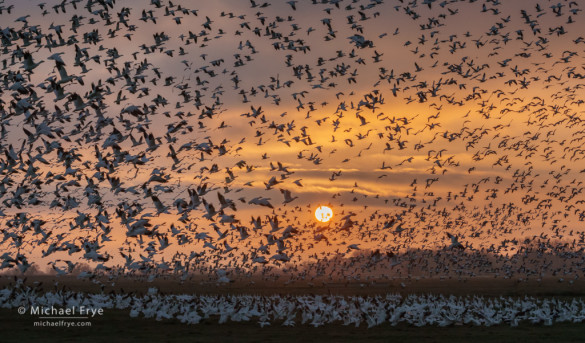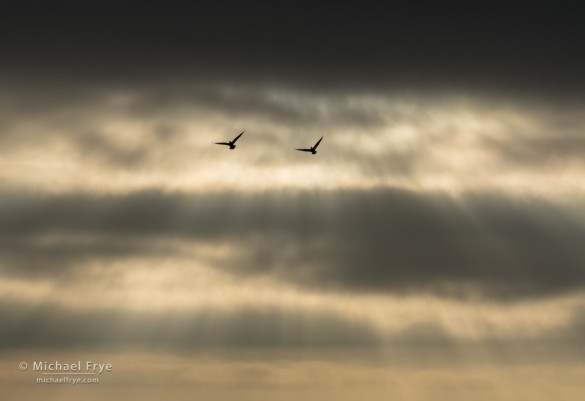It should come as no surprise to any photographer that the interaction between subject and light is important. In fact, I’d say that this interaction is the essence of the whole thing; it’s what photography is all about.
But which comes first? Do you look for an interesting subject, and then find the right light for it? Or do you look at the light first, and then find a subject that fits the light?
I think both approaches can work. But having said that, I almost always think about light first. What’s the light now? What might happen to the light in the next five minutes, ten minutes, hour, or two hours? I try to anticipate how the light and weather might change, decide what kind of subject(s) could work with that light, and only then decide where to go.
While both light and subject are important, light is more variable, and usually less predictable. In landscape photography it’s the element you have the least control over, so you have to adapt to the light, rather than hope that the light on a given day will happen to fit a pre-determined subject.
Adapting to the light doesn’t mean you can’t plan. It just means that the light should be the first consideration in your plans, and you should be prepared to change plans, or at least be prepared for disappointment, if the light doesn’t cooperate.
Last Monday afternoon, for example, I saw interesting clouds on the Yosemite webcams, so I headed up there hoping to photograph those clouds above one of the classic valley scenes at sunset. That was a short-term plan based on the anticipated light. But when I got to the valley the clouds had dissipated, so I had to make a new plan. What would work on a clear, cloudless evening? Well, Horsetail Fall might, especially since it had just gotten a boost in water flow. So I photographed that, and took advantage of something unanticipated to help make it work: the wind.
The photograph I made later that night, of Upper Yosemite Fall by moonlight, was something I’d planned for years. But it involved a particular interaction between subject and light, and the idea for the photograph came from thinking about light first. After making a photograph of Horsetail Fall by moonlight several years ago, I asked myself whether other waterfalls could be backlit by low-angle moonlight at the right time. And the answer was yes: Upper Yosemite Fall could be backlit if the moon rose in the right position.
This kind of interaction between subject and light played a big role in a more dynamic, fast-changing situation a couple of weekends ago, when Claudia and I joined some friends at one of the San Joaquin Valley wildlife refuges. Morning fog had lifted into overcast grayness, so we ran some errands in town, then headed back to the refuge in the afternoon. The stratus deck persisted, but we saw some patches of blue sky, and hints of sunlight. I hoped that the clouds might break up enough to create some interesting skies.
It took awhile, but an hour or so later I noticed sunbeams breaking through clouds to the west. This was a sign that didn’t take a psychic to read: it was time to move! I needed to find a spot with birds between me and those sunbeams, so there would be some likelihood of birds flying in front of that sky.
From the refuge’s observation deck I could see a large flock of Ross’s geese feeding in one of the fields, so I drove around the tour road to get closer. It turned out to be a great spot, with geese frequently flying from one part of the field to another, and passing in front of an increasingly-interesting sky. I took plenty of photos, but the ones from this time period that I ended up liking best usually featured only a few well-positioned birds. Here’s one example:
As the geese moved, fanning out in the field to feed, I adjusted my position too, trying to keep the densest part of the flock between me and the western sky. As sunset approached, bigger sections of the sky started to light up and turn color. I was thinking about putting a wide-angle lens on my second camera body in case a mass takeoff filled that colorful sky with birds. And at that moment they started to lift off.
With no time to change lenses, I zoomed my 70-200 lens out to 70mm, and that turned out to be wide enough. I put the sun just below the center of the frame, and let the birds swirl around it – again, thinking about the light, and hoping that the subjects would cooperate and fly into the composition. Fortunately they did. It was really hard to pick out one frame from this takeoff, but the one at the top of this post is my favorite by a slight margin.
Was this a lucky photograph? Absolutely. But I increased the odds of getting lucky by thinking about the light first, and finding a subject that would work with it, rather than deciding to photograph a certain subject and then hoping the light might cooperate.
— Michael Frye
P.S. A still photograph, no matter how good it is, can’t convey the sound and motion of a mass takeoff like this. Fortunately, Claudia captured an amazing video of the event with her iPhone (be sure to view it in HD):
(Email readers please click here to view the video.)
I didn’t see what triggered the takeoff, but I think perhaps an eagle flew nearby. In the video you can see that the geese were banking and swerving – making evasive maneuvers in the air, which they only do to evade an aerial predator. Since eagles are the only aerial predator big enough to tackle a goose, that seems to be a likely explanation. The only other flying objects that geese seem to feel threatened by are low-flying airplanes, but there were no planes at that moment.
Related Posts: Yosemite Falls by Moonlight; Horsetail Fall by Moonlight; “Ordinary” Landscapes
Did you like this article? Click here to subscribe to this blog and get every new post delivered right to your inbox!
Michael Frye is a professional photographer specializing in landscapes and nature. He is the author or principal photographer of The Photographer’s Guide to Yosemite, Yosemite Meditations, Yosemite Meditations for Women, Yosemite Meditations for Adventurers, and Digital Landscape Photography: In the Footsteps of Ansel Adams and the Great Masters. He has also written three eBooks: Light & Land: Landscapes in the Digital Darkroom, Exposure for Outdoor Photography, and Landscapes in Lightroom 5: The Essential Step-by-Step Guide. Michael has written numerous magazine articles on the art and technique of photography, and his images have been published in over thirty countries around the world. Michael has lived either in or near Yosemite National Park since 1983, currently residing just outside the park in Mariposa, California.











At that moment, you zoomed out and I zoomed in. I think you guessed right! 🙂
Dan, as you know, it’s awfully hard to make those split-second decisions about composition when photographing birds, and you don’t get a second chance! I’ve more often regretted being too tight than too wide for big takeoffs like this, so I’ve trained myself to zoom out. But that’s not always the right decision, as every situation is different.
Brilliant write up and superb image . Watched the video and thoroughly felt at peace watching the natural wonders . Thanks for sharing michael . Truly magical image and video made me feel at the place .
i have a natural tendency to zoom in which I would now purposefully try to change after seeing your photo . Moreover I also feel that adding wildlife to landscape makes image even more interesting .
Well as I said in my reply to Dan, zooming out is not always the right decision. But if you’re relatively close to a large flock of geese taking off, sometimes it’s better to show more birds, which means going wider.
With that many geese overhead I trust you had proper protection against “gifts from above.”
I enjoy your blog and your way of expression as I always do. Thanks.
Thanks George. In this instance they didn’t flow over me, but I’ve certainly been bombed before. 🙂
Thank you Michael and Claudia for sharing this special experience. It is truly a wondrous thing to see a flock of geese take off (I am near Lower Klamath Refuge), and to have that setting sun made the moment even more magical.
You’re welcome Julie, and thank you! I’m glad you’ve been able to see mass goose takeoffs in person – a wondrous thing indeed. You live near some good spots for that.
A wonderful shot and a great video. We were there this Tuesday. Unfortunately, the geese were up in the air and then landed in a field on the other side of the road. However, there was lots to shoot, including a special sunset and a flock of cranes.
Thanks fro sharing,
Doug
Thanks Doug, and I’m glad you enjoyed your visit, even though the geese didn’t cooperate.
Great Article and beautiful work. Thanks for sharing. You are very inspirational.
Thanks so much Louis!
Wow, just incredible images my friend.
Thank you Nate!